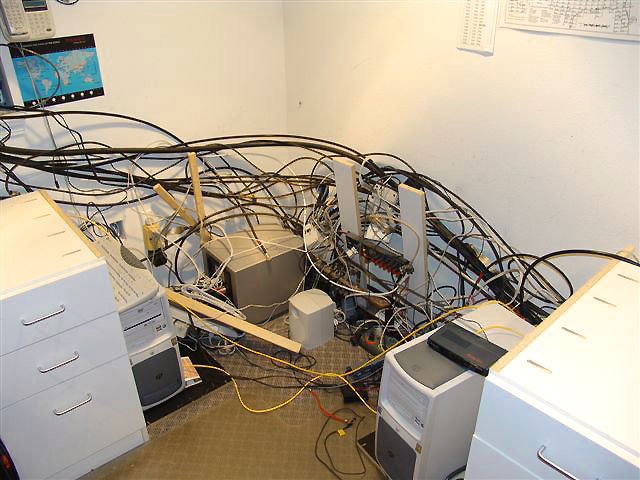
June ARRL VHF Contest 2005
KMØT - EN13VC

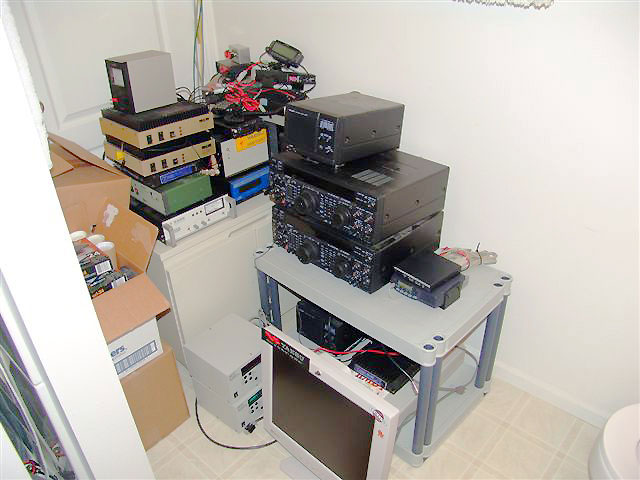
Early Winter – 2004:
“My god, what have I done?” Those were the words I muttered to myself as I stood back and looked at the mayhem of wiring and piles of equipment. I had just taken apart the entire shack and was thinking of what I needed to do first to get it all back together. You might ask “why in the world would you do such a thing?” Well, I blame Gerald – K5SDR from Flex-Radio – the engineer who produces the SDR-1000 software defined radio….
Where does this wire go??
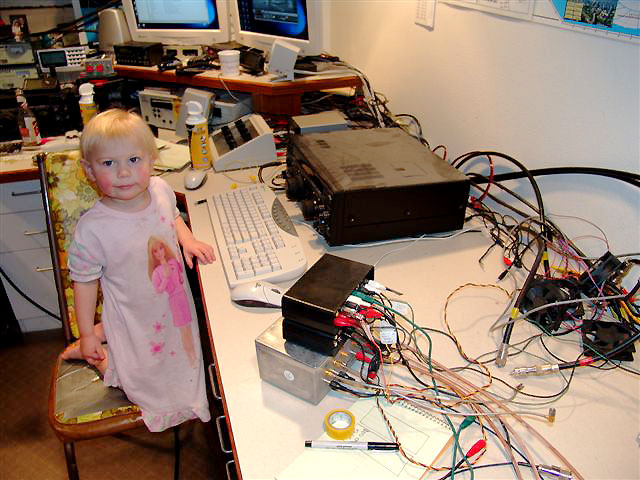
I was planning on integrating the SDR-1000 into the station as the new microwave IF in order to take advantage of it’s bandscope abilities. In short, the radio had come to a point where I could really use it for what I wanted, so it was time to figure out where all the stuff was going to go and how it was to interface with everything. (See my more detailed SDR-1000 page for related integration information.)
Now, the SDR-1000 does not take up that much room, but I wanted to add a computer to dedicate to the running of the radio. But as I got around to adding a CPU, monitor, keyboard, etc. I really was running out of room because I wanted to keep what I had already for the shack layout. Also, while I was trying to figure this all out, I had to get under the desk and trace a bunch of IF cables, DC wiring, control cabling, grounding, PTT routing, etc. This became very tiresome as I had a hard time remembering which and where everything was going. I managed to track it all down, but I also was trying to figure out at the same time where I had some hum issues, i.e. ground loops, etc. This was not able to be tracked but I suspected my custom switchbox that routed the PTT, CW and microphone controls to the various radios.
In addition, I wanted to minimize the 28 MHz and 144 MHz IF interference in the shack. I was planning on routing all superflex (solid jacket hardline) or UT-141 for IF cables for connections to the various transverters.
Over the last 3 or 4 years since I got into all this, I built the shack up as I added bands. This over time while improving the band capability took away from the integrity of how everything was hooked up. Looking at how I had hooked up the stuff years ago was totally different than how I was or wanted to do it now. I simply had more experience and knew of better ways to do things.
As I though about this, I knew I had two ways to go, “Band-Aid” or “Start Over” But I really had a hard time getting started, because I knew that if I “Band-Aided” things, they would work, but it would be a long painful process. I also knew if I went to “Start-Over”, once I began there would be no going back if it turned out to be too much work. More than a few nights were spent lying in bed thinking this all through, with no real definite or defined solution coming to mind.
Weeks passed, and I was starting to think that I was going to run out of time if I was to be up and running for June 2005. So one night, I started tearing stuff apart…apparently the “Band-Aid” approach was not sitting well with me that night. Which brings me back to my first statement in paragraph 1 of this webpage J
The Rebuild Begins:
My wife looked at the mess too, mumbled something to the effect of “like you didn’t have enough to do…” and left the shack. Oh well, I think I knew in my heart this was what I was going to do, but just took time to get there.
During all this, I looked into making more room up on the top shelves by stacking transverters and equipment more than it was. Computer CADD layouts of various equipment configurations (I know, pretty nuts…) revealed that really no good scenario would work with the new equipment being added. So I slept on that for a few nights while in the mean time working on the cabling infrastructure that was to be below the desk.
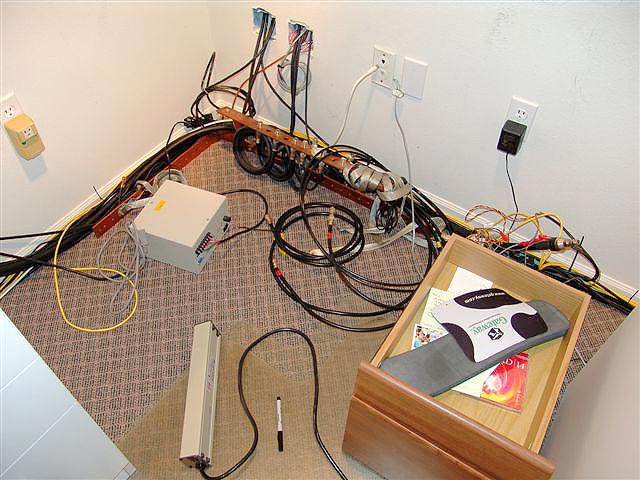
A big step up was moving all the DC power connection away from the MFJ banana jack power panels to power pole panel connections. Man, there are lots of DC connections to all this stuff! And I got pretty proficient at making Power Pole connections! It was the best step though as it really made it easy to hook things up when I got all done, as well as standardize the shack DC power distribution – safer too!
I also changed the FT-1000MP IF rigs from their internal AC/DC power supplies to direct DC. I figured no sense in generating more heat inside these things with the internal supply since I had DC in the shack anyway. So, I broke out the manual and looked at how to change the rigs over to DC. Not a real hard task, but a pain in the butt since both the top and bottom covers have to come off and the front panel loosened. All to move one jumper…uhg….Yaesu – Are You Listening? Wake Up! (Oh well, can’t complain too much, these rigs have been bullet proof!)
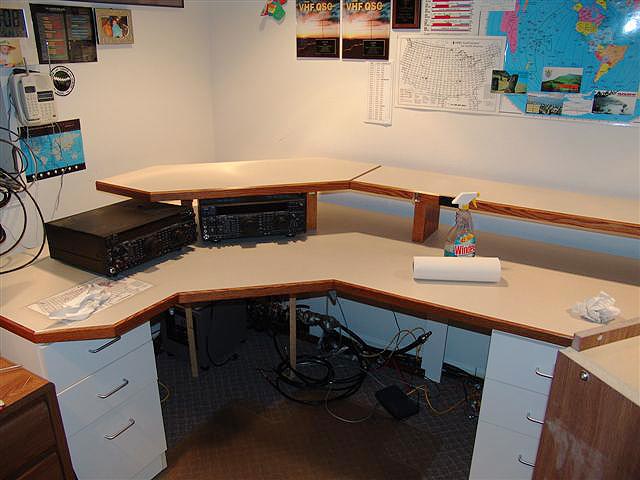 Desk ready for equipment layouts.....
Desk ready for equipment layouts.....
I also moved the power supplies to a wire shelving unit. I was strolling through Menard’s one day and saw it. Not expensive and looked like the ticket. So where the supplies were sitting now, would rotate 90 degrees up against the other wall, thus giving more space. So work had to be done on disconnecting the main DC cables that run along the wall behind the desk so I could move the supplies. Man those things are heavy! (I must be getting old)
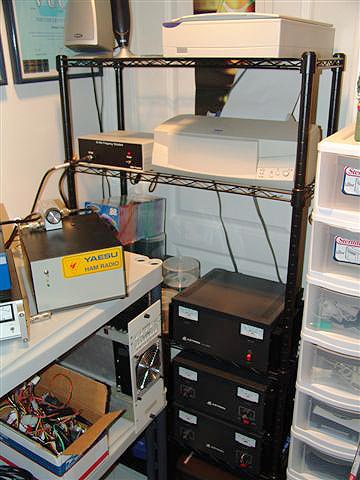 Wire shelf with power supplies and other goodies....
Wire shelf with power supplies and other goodies....
The wire shelf seemed to work out well once I stacked the power supplies on it and reconnected the DC cables. Seeing how robust the wire shelf was and how nice it looked gave me an idea. Why not use another wire shelf and slide it under the desk in the kick space? There was lots of extra room down there and perhaps a shelf cut off to the proper height could be slid under there? Better yet, why not put wheels on it to aid in sliding it in and out….well, it just so happens that Menard’s had wheel kits for this kind of shelving too!
Thus another project within a project was born!
Transportable Contest Station Transverter Deck. The TCSTD
Wow, to think I could mount all the low band transverters and amps perhaps on a shelf below the desk really made my mind start cranking out layout ideas. Some CADD layouts (I know…really nuts now…) confirmed that this might just work out. And boy did it free up room on the above desktop!
A wire shelf (with the wheel kit) was procured and I started laying things out on it. It appeared that I would be able to mount the low band transverters and amps, along with the required supporting infrastructure. The idea bloomed into thinking that if I could make it a robust “self contained” unit, then I could take it out of the shack for portable operation and be up and running in a matter of minutes – just hook up the antennas, IF rigs and DC power! With that approach the layout began to take shape.
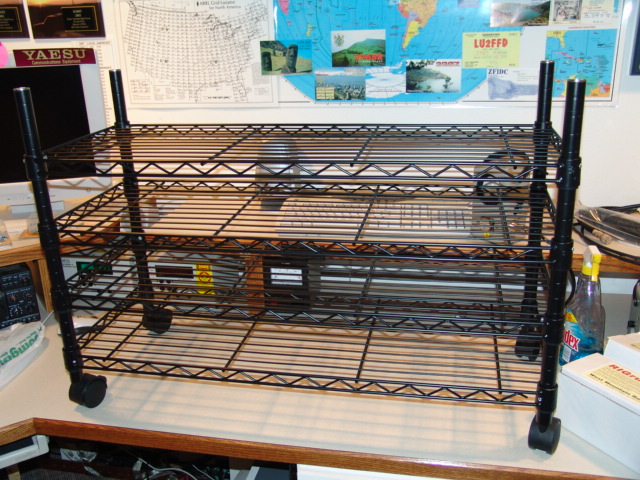
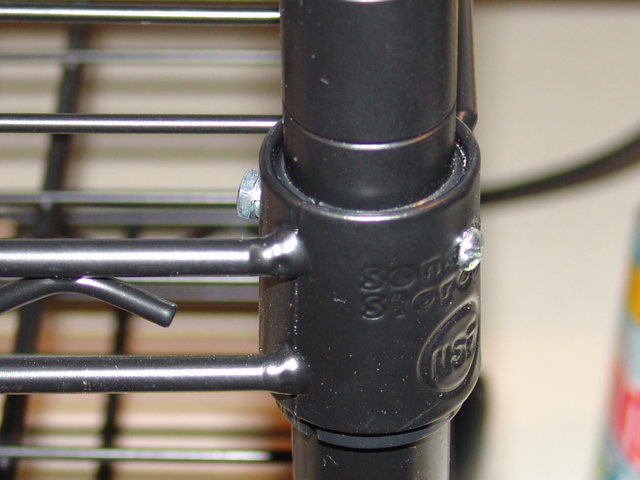
One neat thing was to put a Power Pole distribution panel right on the TCSTD. Thus eliminating way too many independent DC feeds to the whole rack unit. The TCSTD ended up having only one DC feed to the Power Pole panel for miscellaneous loads, and DC feeds for the 6 Meter and 2 Meter TE System 350 Watt amps. The Teletec 222 MHz and 432 MHz amps got their feeds from the Power Pole panel.
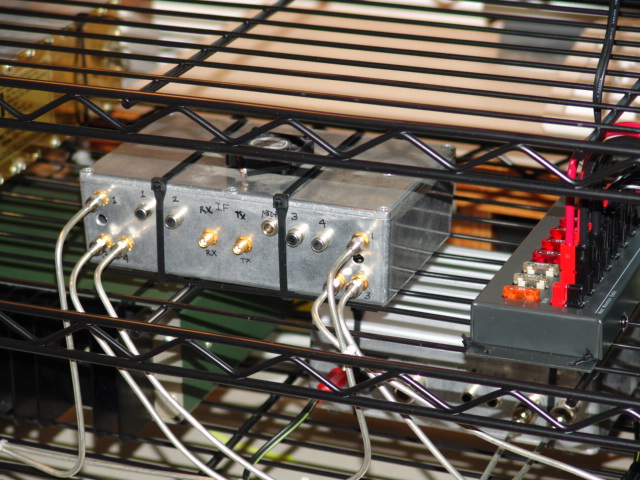 IF Switch and Power Pole Panel.....
IF Switch and Power Pole Panel.....
The IF switch was mounted on the rack and routed the 28 MHz for 144, 222 and 432 MHz transverters. I decided to keep the 50 MHz transverter independent on a separate IF radio. If the TCSTD got taken out for portable operation, then two guys could operate separate IF radios at the same time. One for 6 Meters, and the other for 144, 222 and 432 MHz. The IF switch just needed a simple connection to an AV switchbox for switching bands and routing the PTT on the higher bands. This was different from the previous shack layout as I had 144 and 432 MHz on one FT-1000MP as an IF with 50 and 222 MHz on the other FT-1000MP. The new configuration seemed to make sense as 222 MHz had become more popular and the QSY up the bands from 50, 144, 222 to 432 MHz seemed to be more staightforward.
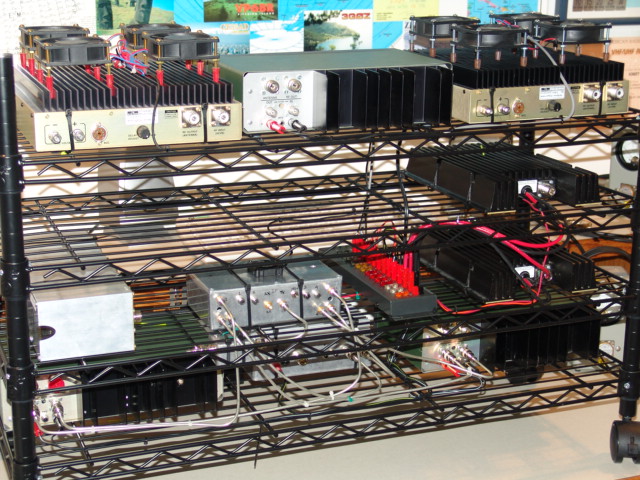 TCSTD Building In Progress.....
TCSTD Building In Progress.....
In the past, I had always been a bit disappointed with IF overload from one IF rig to another. During the whole shack rebuild, it was planned that the IF cables between the IF rigs and IF switches should be made of hardline of some sort, in lieu of coax braided cable. With that idea in mind, all the RF cables from the IF switch on the TCSTD were made out of UT-141. This worked out well as it helped hold things in place on the wire rack once they were zip tied down. The transverter IF connections were BNC type connectors. So a call to “The RF Connection” resulted in some good adapters. I also obtained some SMA to SMA bulkhead adapters for the IF connections to the rack. With that, then I could run UT-141 from the FT-1000MP IF rigs to the rack itself.
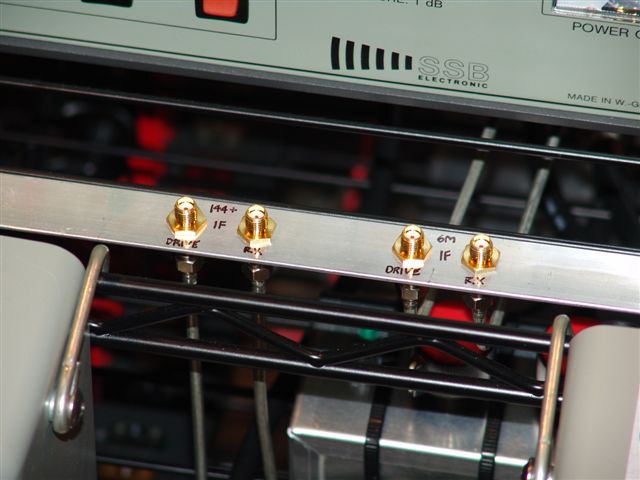
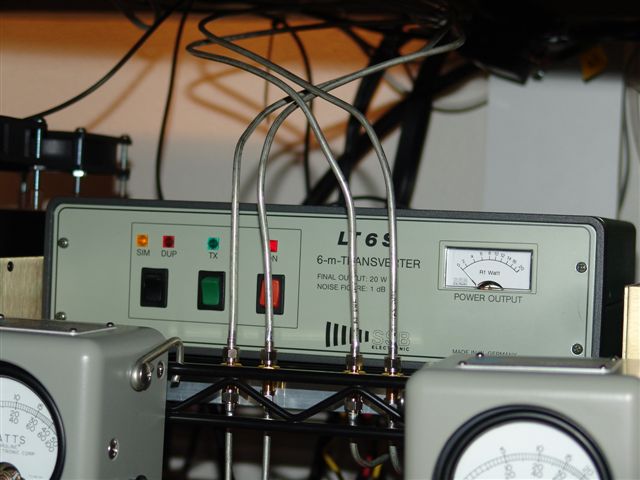
I then wondered about how to get my Bird watt meters to measure the power output from the amps. Again, thinking of a self contained unit, I came up with an idea to mount the watt meters for each band on the rack itself. I took the plastic strap off the top of each meter and used some scraps of UT-141 to make hooks. This worked out great as these short lengths of UT-141 were very sturdy, but yet I could bend them the way I needed to make the hooks.
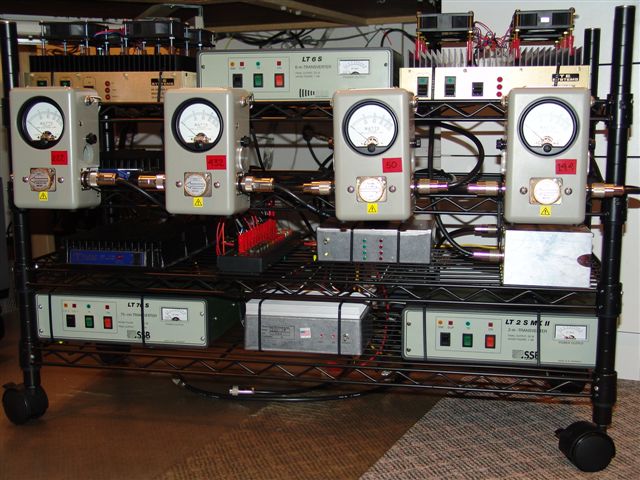
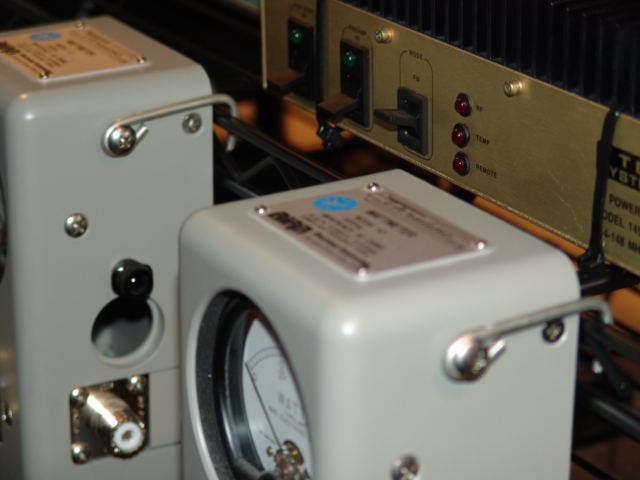 Bird Meters with UT-141 Supports.....
Bird Meters with UT-141 Supports.....
I made all the RF and DC connections and zip tied them to the wire frame of the rack. Nothing moved around and it seemed to make it a very reliable system. From there, the fans for the TE Systems amplifiers were mounted and the rheostat control for fan speed was tied to the rack as well.
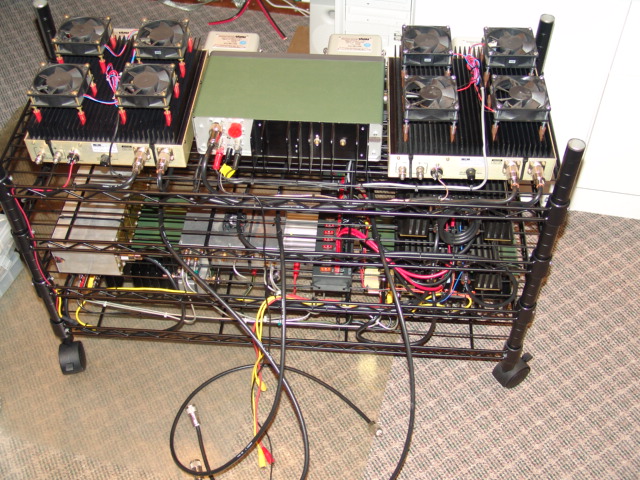 Pretty much done!
Pretty much done!
Testing the TCSTD:
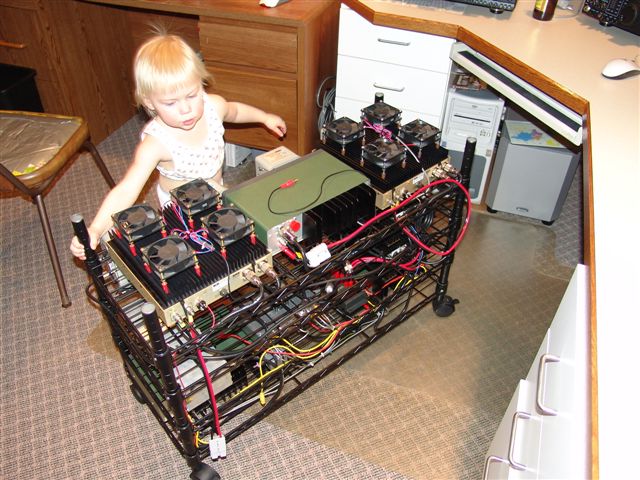 Jenna moves the TCSTD into Position.....
Jenna moves the TCSTD into Position.....
When all was wired up, I slid the whole assembly under the desk and made the IF, DC and RF connections. I then routed the RCA cables for the IF switch and PTT control up to the AV switchbox. I applied power to the IF rigs and the TCSTD and all was well. I noticed that I still had IF overload from one rig to another, but it was greatly reduced, so that was a big improvement. I again never had a problem with this, but I just wanted to reduce it if I could. I think the only way to eliminate it is to use a different IF frequency on one IF rig such as 29 MHz in lieu of 28 MHz on both.
I made a few contacts and on all the bands and figured it was good for now, off to other things to do! Some days later however, I realized that on 222 MHz, the drive was way too much and was distorting the SSB. I had to reduce the RF drive gain on the FT-1000MP to almost nothing to make it work right. On CW, it seemed to work just fine. It was the day before the contest and I was not about to move the rack out and look things over. All in all the TCSTD was a great idea, but it just took a bit more time to roll in and make connections than what I thought it would. The space was a bit tight under the desk and I did not want to mess things up right before the contest.
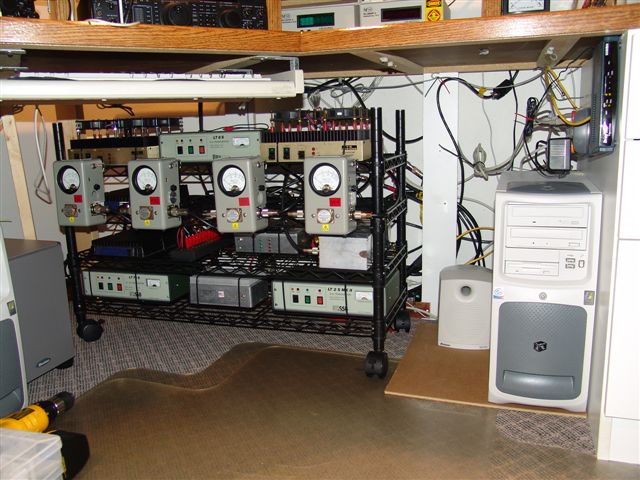 It just fits.....
It just fits.....
I thought about this some more and figured I knew what the problem was but I would have to fix it later. The problem was that when I used my original FT-1000MP as an IF for 144 and 432 MHz, I needed a MAR amplifier to increase the transverter port output from the FT-1000MP. The transverter drive from these rigs is pretty low, so I obtained a MAR amplifier kit from DEMI years ago. It worked great for increasing the drive to get the SSB Electronics transverters output to 20-25 watts.
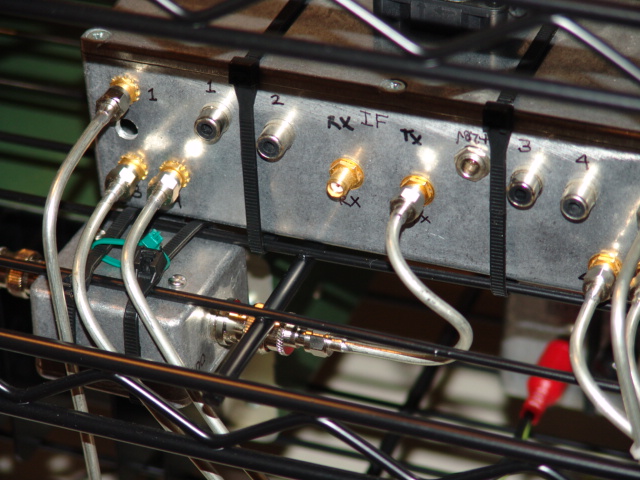 DEMI MAR Amplifier feeding TX Port on the IF Switch.....
DEMI MAR Amplifier feeding TX Port on the IF Switch.....
However, when I added the second FT-1000MP as an IF for the SSB LT6S 6 Meter transverter, I never needed a MAR amplifier. This second FT-1000MP was one the last new ones off the line, and apparently the drive output was more then the older runs of production. I believe I read about this issue on the internet and the older runs had some issues with transverter port output. However, I purchased the 222 MHz transverter from DEMI with the hotter drive input option, that way I would not need the MAR amplifier in front of it. As it turned out, I needed to adjust the attenuator in the 222 MHz transverter a bit to get that to work right.
When I moved the 222 MHz transverter to the other FT-1000MP, the drive source was from the MAR amplifier via the IF switch. I just hooked it all up as I did with the SSB Electronics 144 and 432 MHz transverters. So the drive via the MAR amplifier was just way too much. However, I forgot to adjust the attenuator in the 222 MHz transverter to get things in line. The adjusting of the RF drive control on the FT-1000MP confirmed this. In order to fix this, I would have to remove the whole TCSTD and take the 222 MHz transverter apart to get to the attenuator potentiometer. This would take an afternoon’s time and with the kids running around screaming, my time was limited J
So I just dealt with the RF drive control issue during the contest. It was more than a few times after being on 222 MHz that I was not being heard on 432 MHz, as the drive being adjusted very low for 222 MHz, was not enough for 432! A few “Oh, there you are now” and “I thought you dint make it here” was enough to make me remember to readjust the drive control towards the end of the contest!
Shack Controller – The Multi-Switcher NCS-3240!
I had built a custom switchbox to route the PTT, MIC, CW Keyer and Headphone audio from all my IF rigs. That way I would not have to utilize multiple mics, keyers, headphones, etc. This custom box was built out of old parallel port switch box switches, and it worked pretty well for quite some time. However, the years of switching this thing during the contests had taken its toll, and was “intermittent” in some cases in terms of making connections. I was getting tired of fixing it, banging on it, jiggling switches, etc.
I had been looking at the NCS-3240 from New Communications Solutions for a few years now and began emailing NCS about the integration into my shack. Doug – K4SWJ, the President of New Communications Solutions, was very good about getting back to me with technical answers to my specific situation and it looked like it was going to be a very good solution. It might not be as flexible as the way I had built my own switching system, but I found out over the years that I did not use that flexibility. So it looked like it would be almost a direct replacement for what I actually would use it for.
So I ordered the NCS-3240 with its recommended power supply. Time was limited, so I also ordered the FT-1000MP cables, a cable for the WSJT Rigblaster interface, a cable for my Kenwood FM Rig and a cable with a loose 4 pin mic connector for my SDR-1000 connection.
With that in hand, I routed the cables and made all the connections except the WSJT stuff. I had a bit of work to make my SDR-1000 cable as it was too short. So a visit to the junk box for some old cables with big DIN connectors resulted in an extension of sorts. Just a bit of soldering and ohming out the cables was all that was needed to get it all figured out.
I then hooked my Heil Headset with boom mic into the system and also my electronic keyer with Bencher Paddles. With that done, all I needed was review the user manual on the NCS-3240 to set the jumpers and mic drive level pots.
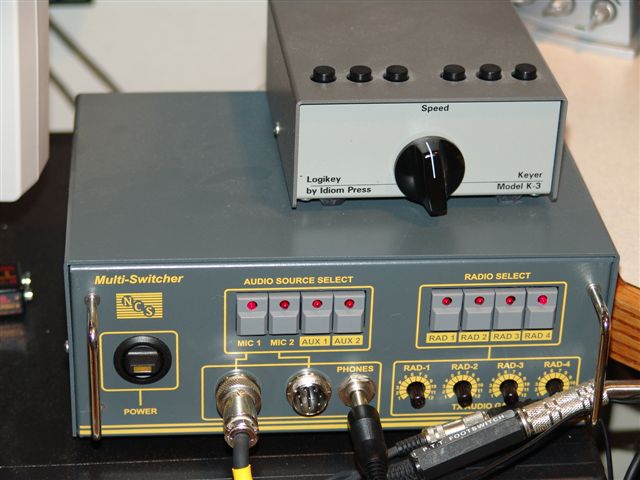 NCS-3240.....
NCS-3240.....
Now, I have gotten lots of equipment that has been made by Hams, for Ham radio use. There was always some issue, whether it be antennas, rigs, interfaces, documentation, etc. However, the NCS-3240 was the first thing I have ever gotten that worked completely and correctly as stated after doing the proper adjustments from the users manual. This thing is totally awesome! I never do reviews on equipment, but I can wholeheartedly recommend this piece of equipment! The pre-made cables were also professionally constructed and worked without a hitch!
With it all hooked up and the flip of the power button, it can switch the CW, MIC, headphones and route the PTT to one of 4 rigs. All one has to do is to hit the appropriate button. It can also have the input of two microphones, but I only hooked up my Heil boom mic. I was not able to hook up the WSJT interface for the contest; I was just running out of time. I had no indications of ground loop hum between the rigs or microphone audio issues. All the on the air reports were excellent!
SO, if you looking for something to control the shack in this manner, give the New Communications Solutions website a look. You might find something there that will work for you. Note to the competition, you DON’T need this device J
3456 MHz Woes:
My 3456 MHz tower box had been exhibiting some clues that it was not putting out power again. The monitor voltage on the 15 Watt DB6NT amplifier was not giving me the level that I was expecting. A few on the air contacts seemed to confirm that the RF output was way down.
With that, the main tower had to get lowered down in order to take off the tower box. This seemed to be a yearly occurrence, as the power output had gone away in the past. My 3456 MHz DB6NT transverter had gone back for service to Gerry at SSB Electronics the year before for the same reason, low power output. As it turned out then, he had to retune the cavity filters to get the power output back to specs. Back then, we were both scratching our heads wondering why the cavities went out of tune.
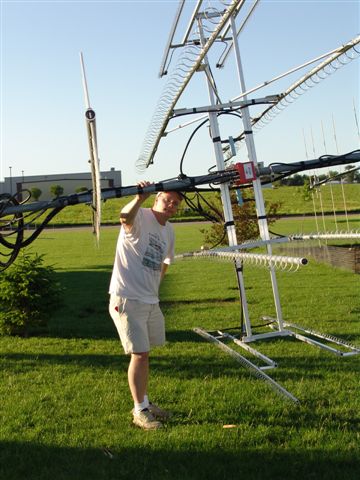
We compared the conditions that the transverters were living in, one in the tower box – exposed to the harsh winters and hot summers, and my other 3456 MHz transverter built into a rover box, which sat in the shack most of the time. Both transverters at the same time seemed to go out of tune, and being in different environments did not seem to make any difference. One other thing is that the tower box that housed the 3456 MHz transverter also housed the 2304 MHz transverter, which had never had a problem for the 3 years it had been up on the tower.
I got the tower box on the bench, sure enough the transverter and amp combination was giving only about a half a watt. A gave a quick call out the Gerry at SSB Electronics about the problem. It was decided that perhaps I should try to retune the cavities. If I screwed it up, then I would have to send it in. But I would have to send it in if I was not going to try to do it myself in the first place.
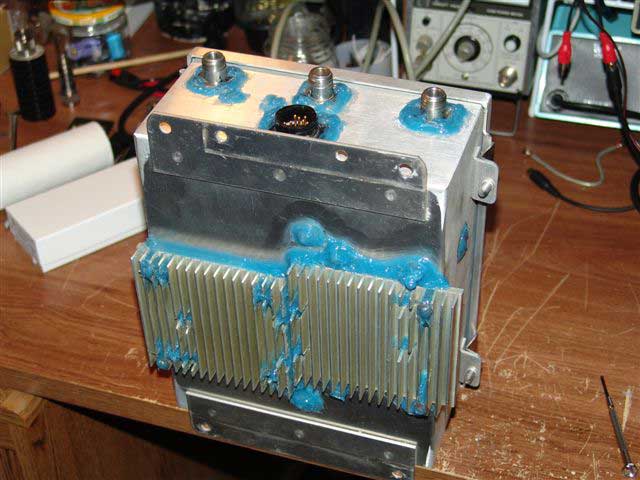
Might as well re-goop the box since it's off the tower....
So, I started with a metric wrench on the transmit cavity nut and a good screwdriver on the tuning screw. All I had to do was move it “just a smidge” and BAM, the power was right back where it was supposed to be. A quick once over back and forth and good tightening down was all that was needed. From there, I resealed the nut with some goop and put the cover back on. One more disaster avoided! I got things back on the tower and tested out just a few days before the contest.
5.7 And 10 GHz Tower:
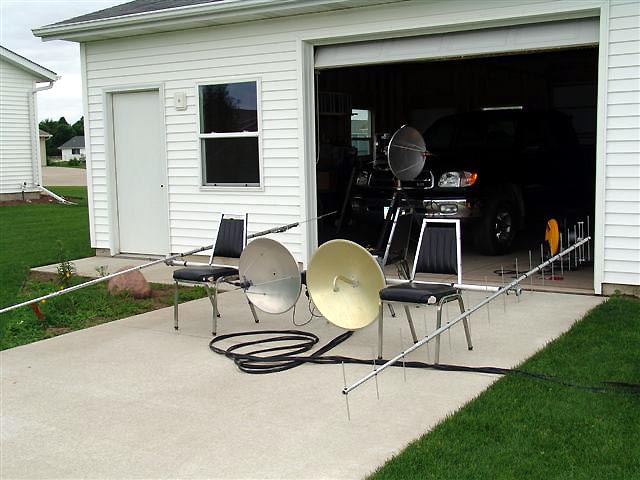
To make a long story short, I took the microwave tower down for maintenance and some “refitting” of the 5.7 and 10 GHz band boxes with OCXOs. This work was not completed by the time the June Contest came around, so I was not really active on these bands. I did have my dual band dish located in the garage for some QSOs if the opportunities arrived, but I was not counting too much on these bands.
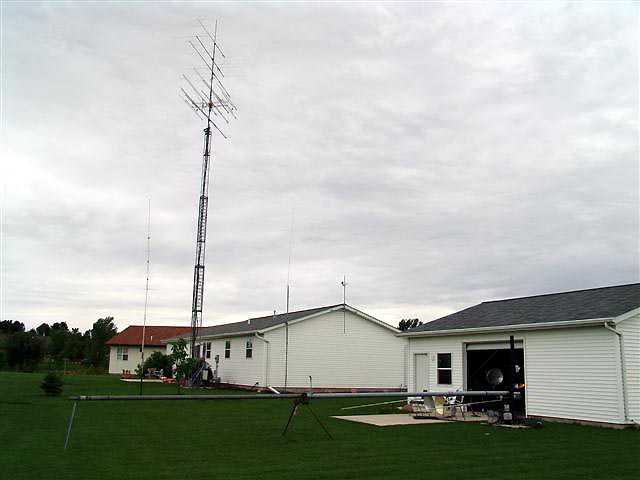 Right before the contest - Microwave tower is down.....
Right before the contest - Microwave tower is down.....
The SDR-1000 Gets Hooked into the System:
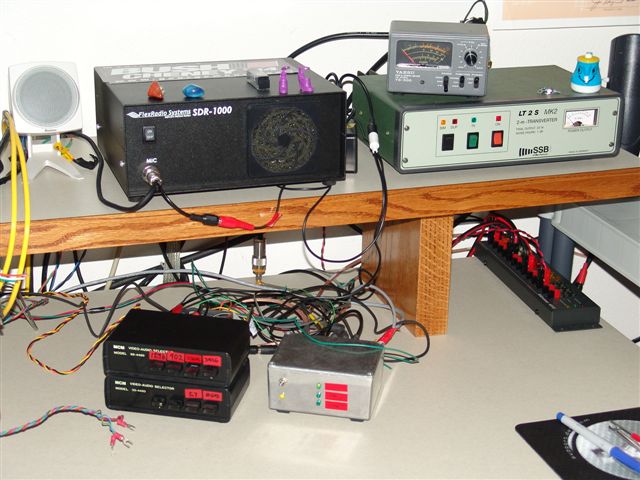 SDR-1000 Ready to Go!
SDR-1000 Ready to Go!
After the TCSTD work was basically done, the SDR-1000 got moved into place with it’s CPU and support hardware. Testing was all done with version 1.2 of the software and the IF drive levels got set. The shack rebuild had destroyed all my control cabling from the AV switchbox that controlled the microwave IF switch, so a night was spent scratching my head wondering how I had hooked all this stuff up. A slow and methodical approach of getting one band working at a time seemed to work well, and before you know it, things were pretty much back to normal with the SDR-1000 playing well as the IF for 902, 1296, 2304 and 3456 MHz. I used one of my first IF switches I built some years ago. I blew the dust off it and applied power!
A few on the air tests gave some good feedback. In fact Friday night before the contest, I was working Dave – NØKP up in EN34 via rain scatter on 2304 and 3456 MHz. The signals were extremely weak on 2304 MHz rain scatter (my first RS contact on that band) so if I was able to pull that off, I figured all was working well! Again, see the SDR-1000 detailed implementation on other parts of this website. Oh, and thanks go to Gerald from Flex-Radio for making me tear my shack apart!
The Contest:
The shakedown began fairly uneventful. Worked a few locals like Nathan KØNPR as he jumped in there to get me rolling. Always good to have local support right at the beginning. Thanks Nathan!
Got Bob out of the way right then too….K2DRH…happened to catch him and work thru 2304 MHz. The SDR-1000 was “Contest Christened” as it bagged Bob on the high bands! The conditions were not all that terrible, as we ran right up the bands with little effort.
Then caught up with a few EN34 guys on the low bands, NØKP, WØJT – we decided to try the higher stuff later. Hearing this chatter, Justin – K9MU gave me a call. Good signals from him out of EN44 and worked him thru 1296. I could tell K9MU was pretty fired up as he was heard up and down the bands bangin em out!
Then Jim – KØMHC/R was worked out of EN26. Pretty good for the beginning of the contest to hear him. The rovers can be pretty busy right at the beginning. Managed to get Jim through 2304. Again the SDR-1000 was doing a great job as the microwave IF.
After that, a few more QSOs were had with NØVZJ, WØAUS and WØGHZ from EN34 and EN35. Gary – WØGHZ was worked through 3456 MHz with fair signals at that point.
Things were pretty dry after that first couple of hours, so I took a break and went out to work on the dish tower. It was a beautiful day, so it was nice to get out of the shack.
After messing around abit, I ran into one of my neighbors. He was looking for some wire to hook up his boat trailer. I took this opportunity to take him down into the shack and give him the “nickel tour”. After that, I dug thru a few boxes and came up with some wire. The 6 meter band popped the squelch a few times and I jumped over to work XE2K in DM22 and a few others in the southwest. He thought that was pretty cool, even though he had no idea what was going on. I explained a few things to him and we had a nice chat. No phone rang the whole weekend, so I did not get any TVI complaints from him, at least not yet! Its always hard breaking in a new neighbor, you just never know what or how they will react.
After that and the rest of the day, the Es were spotty down to the south and southwest. I didn’t hit it real hard, but the fishing was not all that good. The band simply would not stay open on 6M. But again, this was the shakedown for the new station layout and the kids were coming in and out, seeing what was up. I had to go up and have “Freezy Pops” a few times J
Towards the evening, I hooked up with Dave – NØKP and Gary – WØGHZ. We were meeting on the hour on 144.180 to “re-evaluate” the thunderstorms that were developing between us. KØSM - Andy’s program “RainScatter 1.0” got a workout and we were busy plotting paths. Around 0200, the cells were looking pretty good, so I ran outside to the back patio of the garage where the 5.7 / 10 GHz portable dish was setup. NØKP and I completed on 10 GHz pretty much right away with S1 signals. I then tried to work Gary, but nothing was heard. I switched to 5.7 GHz and could not raise them at that point. So, I quickly ran down to the shack as I had no liaison radio at the garage and asked the boys to QSY to 5 gigs.
A quick trip back up to the dish resulted in NØKP and WØGHZ on 5.7 GHz. Gary’s signals were very good. However I was not able to complete on 10 GHz with him. It was nice to know however that the dual band dish was working!
I then managed to pick up a few on 2M and a few other bands, it was nice to catch Ken - NØGZ in EN31 and Chris – NØUK in EN34. I finished the night out with QSOs from Jim - KØMHC/R in EN24 / 25 and Gene - NØDQS/R from his home grid in EN22. Gene was going to possibly be on the air Sunday, but family commitments were perhaps going to get in the way, so he decided to get out at least EN22. Thanks Gene! So we chatted for a while, getting caught up on a few things and Phil, NØPB from EM39 popped in there, we all “round-tabled” for a bit as Phil had a nice signal that night.
The morning started out pretty good. Ray – WBØHHM from Sioux Falls was worked for a few contacts. Bill, KØAWU came out of the noise and was worked on 144 and 222. I then ran into a flurry of rovers right away, it’s a good way to wake up!
KØMHC/R in EN23 / EN22 and EN12 was worked on all bands thru 10 GHz. He was not all that far away, so the low bands were not a problem. But I had to run back and forth from the shack to get to the dual band dish for 5.7 / 10 GHz. All paths were obstructed by the houses around me, but my 4 watts burned through the neighbors so Jim could get his 200 mW 10 GHz signals to me. After that we would switch to 5.7 GHz where signals seemed to be much better. I had my truck in the garage right next to me, so I turned on the 146.550 FM rig and did liaison with Jim there, not bad from inside the garage!
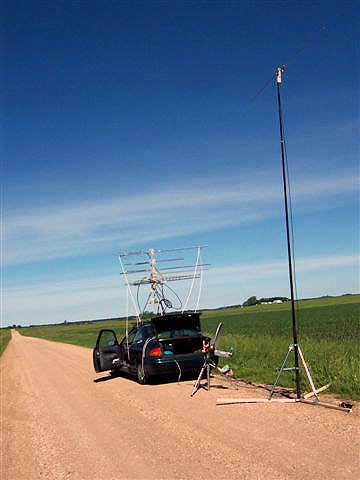 KCØIYT/R...Setup
with 6M Dipole
KCØIYT/R...Setup
with 6M Dipole
This is when I first ran into Glen – KCØIYT/R. He was in EN23 also, but near the EN34 corner. However, Glen’s rover was working good and he was worked thru 3456 MHz. He did not think we would make it on 902, but the SDR-1000 IF saw his very weak SSB and I was able to make the QSO!
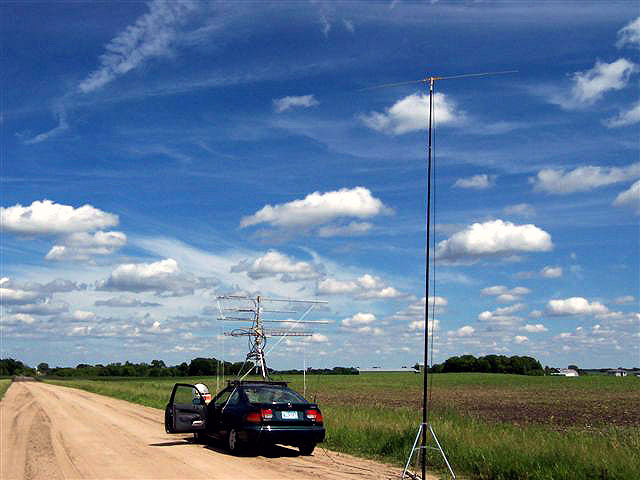 K
K
Then Jon – WØZQ/R was found in EN34. I worked him on 2M and then thru 3456 MHz. Good signals on those bands from Jon even at the top of the EN34 grid. However, his 2304 was broke, so no joy there. We tried on 10 GHz as he was now running a high power 10 GHz dish setup, but nothing was heard. Bummer, no rain in the area that morning!
The flurry of rover contacts with bands 902 thru 3456 MHz really gave the SDR-1000 IF radio a good test for quickly running through the bands. The technique was to have the rover send a CW beacon for starters. When I saw the blip on the bandscope, I would click on it in the CW mode. I would then yell back on the liaison freq that I found them. At that point I would switch the SDR-1000 to USB and give them a shout! With that method, they would be on frequency every time on USB, making the weaker SSB signals easy to understand without any tuning around. Of course with Jim being closer, he just called on USB and the huge signal on the display was easy to see. However, it took a bit of practice to get a feel for where to click on the signal in the USB mode. I could get on frequency pretty well 90% of the time, but if not, I would have the SDR-1000 set to 100 Hz tuning steps. This made it quick to get closer in frequency so that Jim wasn’t sounding like Mickey Mouse!
Around 1500 UTC, I heard Terry- WØVB working Charlie – NØAKC in EN44, so I jumped in there. I had worked Terry on 2M the day before, but I needed him on the other bands he had. After we got done, Terry and I chatted about 10 minutes about the SDR-1000. Terry was using his SDR-1000 as well for a few bands, and we exchanged some good information. We had recently done a presentation together at the NLRS Aurora conference a few months earlier about the SDR-1000. The presentation related to more VHF applications for the radio as Terry has been one of the big users and advocates for the neat little radio. We also discussed the ins and outs for an upcoming presentation that he had been asked to do at Central States VHF Society Conference in Colorado Springs. That was just a month and a half away, so it was nice to get a chance to get some ideas bounced around. With the SDR-1000 improving on a daily basis from the software updates and features, the content of the presentation we are thinking about one day could very well be different the next!
A few more stragglers were found on 2M and also ran into John – WØJT again and we managed to eek out a 1296 contact. Rovers KCØIYT/R in EN33, WØZQ/R in EN35 were found and worked thru 3456 MHz. I tried with Jon WØZQ/R one more time on 10 GHz, but no go again. However, from EN35, the rest of the bands were great. Jon’s rover ROCKS!
Jim, KØMHC/R was just down the street at the Hardee’s having lunch, so he set up and we worked me from there. I went to the garage again and turned the dual band dish towards the south of town towards him. I was shooting through my garage wall and the entire neighborhood. Good signals nevertheless. After that Jim stopped by for a “Rover-Encounter” and he said that he enjoyed his lunch at the new McDonalds in town, which was complete 90 degrees from where I was pointed….hehehehe…its only a half a mile!
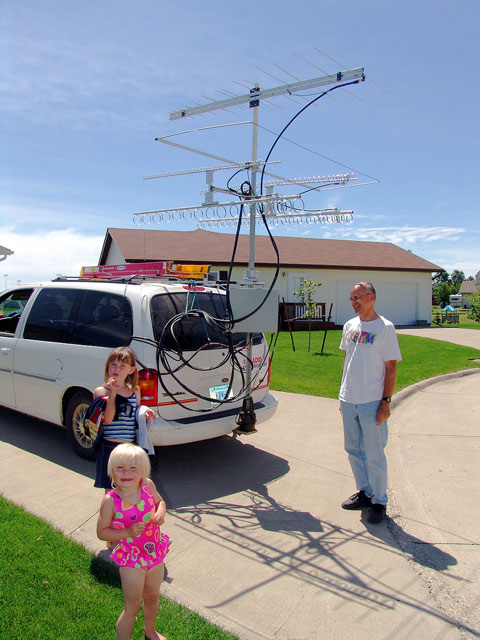 K
K
We spent some time going over his rover setup, giving me the ins and outs of his recent changes and additions to the configuration. All looked really good. I was very impressed with the Honda generator that was feeding an Astron RS70 DC power supply. That looks like the way to go! We then strolled around the yard and showed him the status of the microwave tower project, which was in pieces on the ground and laid over L A trip to the shack showed him the SDR-1000 setup as well as the progress on the 24 GHz tower mounted system. (Hope to be coming to a grid near you during ROVERMANIA II)
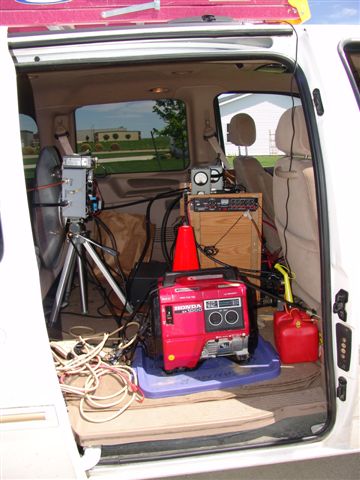
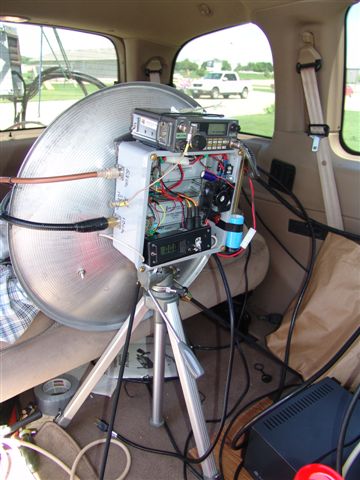
K
ØMHC/R Generator and Dual Band 5.7 and 10 GHz Portable Dish
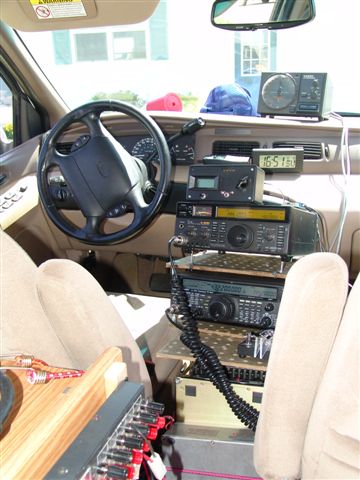 K
K
Things were pretty quiet then, so I took a break and had some lunch. I came back at 1905 UTC and heard raspy voices on 6 Meters to my surprise. There was Rex – KØKP from EN36 coming in loud and clear on SSB via Aurora. Wow, there were others too and it seemed to be building….strange as it was kinda early in the day for any aurora.
Well, so much for my nice and laid back contest, because I worked K9NS right after that from EN52. They told me to go to 2 Meters. Well 2 Meters was open , there they were no problem. Well, they then told me to go to 222. Huh? Can it be that good yet? Sure enough, a quick call on CW and the came back on aurora! It was off to the races!
Then I heard Jon – WØZQ/R in EN25 – had to work him quick, did not want to miss any aurora. You know these things don’t last long…..
Well, between rovers and aurora, I was busy the next number of hours. (My last aurora contact of a good distance was 0118 UTC – nearly 5 hours later!)
I spent the most time towards the beginning on 6 Meters, as it seemed that the folks had not found out yet on 2 meters. So a number of stations were worked there before I started bouncing back and forth. Then the QRM got so bad that the rover frequencies on 2 Meters were being covered up…..oh boy I was never going to find them again. Well as it turned out they found me a few times too. I got a few KC down from 144.200 and was working a slug of guys when WØZQ/R found me. I also heard KØMHC/R on the calling frequency of .200 and yelled in there to QSY to another frequency of .160. Boy, that was busy too! How Glen – KCØIYT/R and I got together after that, I don’t remember as it all became a blur. One thing for sure was that the rovers I could now work on 50 MHz! The AU made it easy!
Once things got going good, 6 meters was not all that exciting for DX wise and speed of the multipliers. I found that at least for me, I called and called CQ and got few replies. But I could get guys attention while they were calling CQ. I guess its an ERP thing and my dinky 5 element 6 Meter antenna. So I decided to spend more time kind of DXing on 2M.
I found .193 to be open and kept it there for quite some time. Worked a long sting of guys and started to hear some weaker ones….what? EM?? And W5?. Sure enough, the aurora was really stretching south. I had W5s coming back to me and I was working em! Notably: W5VHF, K5UR, N5DL and KM5ES.
The aurora made it easy to catch some of the somewhat local guys that are kind of hard to find sometimes. A few of these were Larry – NØLL EM09 - 6 thru 222. Dennis, NTØV EN08 - 6 thru 222. Bob – K2YAZ EN74 144 and 222. John – KØJO EN26 – 6 thru 222. Randy - KAØZEE from EN05 on 2 Meters, etc.
I also manage to work a few rovers I had not heard all weekend. I got hold of Matt – KFØQ/R in EN44 on 2 Meter SSB aurora. I had to talk reeeealllly slow though J He was talking to KØUD in EN08, so I worked him too! Bruce – W9FZ/R was caught also on 2 Meter CW aurora from EN54 and EN55.
A few more grids with Jim – KØMHC/R – EN15 and EN16 pretty much closed it out for the SDR-1000. Again, the signals were “clicked on” and the QSO made…QED.
For the last bit of DX, WB9Z – Jerry in EN60 came banging in via tropo right at the end, we worked on 144 and 222 but could not go up from there. I ended the contest chatting with a local newer ham, Nick – KC0RMR out of Hudson just to my west and had a few QSOs to KB0PJL and KB9TLV in EN44 and EN45. The last 10 minutes of the contest, I listened to the mayhem on 144.200 and took it easy. I looked to my right….nope…no smoke coming from the SDR-1000!
Contest Summary: KMØT SOHP
| Band | QSOs | Pts | QSO Pts | Grids |
| 50 MHz | 126 | 1 | 126 | 64 |
| 144 MHz | 96 | 1 | 96 | 50 |
| 222 MHz | 40 | 2 | 80 | 22 |
| 432 MHz | 36 | 2 | 72 | 16 |
| 902 MHz | 20 | 3 | 60 | 15 |
| 1296 MHz | 25 | 3 | 75 | 16 |
| 2304 MHz | 15 | 4 | 60 | 12 |
| 3456 MHz | 17 | 4 | 68 | 12 |
| 5760 MHz | 6 | 4 | 24 | 5 |
| 10 GHz | 5 | 4 | 20 | 5 |
| 24 GHz | 0 | 4 | 0 | 0 |
| Totals All Bands | 386 | 681 | 217 |
KMØT CLAIMED SCORE: 147,777 SOHP
The contest was a lot of fun, not a great score, but enough to give the new shack setup a good shakedown. The Aurora was a bonus!
SUMMARY CONTESTS PAST
| YEAR | SCORE | QSOs | GRIDS | PROPAGATION | ACTIVITY |
| 2004 | 263,836 | 497 | 284 | 94 Grids on 6M - Bad Tropo - 38 Grids 2M | 50 thru 24 GHz |
| 2003 | 389,754 | 675 | 367 | 163 Grids on 6M - Fair Tropo - 47 Grids 2M | 50 thru 10 GHz |
| 2002 | 151,105 | 412 | 235 | 94 Grids on 6M - Poor Tropo - 38 Grids 2M | 50 thru 10 GHz |
| 2001 | 283,725 | 524 | 325 | 114 Grids on 6M - Fair Tropo - 57 Grids 2M | 50 thru 3456 MHz |
| 2000 | 136,408 | 433 | 235 | 121 Grids on 6M - Fair Tropo - 45 Grids 2M | 50 thru 1296 MHz |
As far as a rating for the year 2005 - Bad tropo conditions.....the Aurora skewed the grid numbers on 2M which was a good thing, otherwise it would have been a bust. The same goes for 6 Meters, as hardly any Eskip was experienced. The Aurora helped out there as well!
"The Rover’s Corner" ©
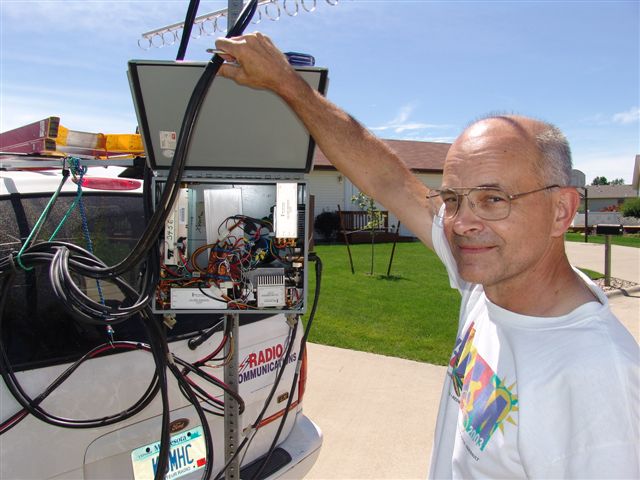 KØMHC/R
Shows Off the Microwave Box!
KØMHC/R
Shows Off the Microwave Box!
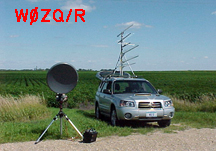
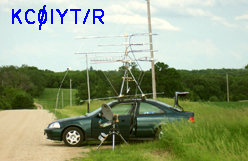
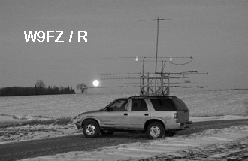
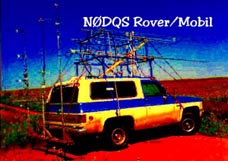
What can I say, the rovers helped out. Here is the chart of Rover activity I worked: Looks like Jim, KØMHC/R got the "Rover's Corner" award this June! Thanks Jim!
| BAND | KØMHC/R | WØZQ/R | KCØIYT/R | NØDQS/R | W9FZ/R | KFØQ/R | E-SKIP/R |
| 50 MHz | 9 | 3 | 1 | 2 | |||
| 144 MHz | 12 | 4 | 3 | 1 | 2 | 1 | |
| 222 MHz | 10 | 4 | 3 | 1 | |||
| 432 MHz | 10 | 4 | 3 | 1 | |||
| 902 MHz | 9 | 4 | 2 | 1 | |||
| 1296 MHz | 9 | 4 | 3 | 1 | |||
| 2304 MHz | 8 | 3 | 1 | ||||
| 3456 MHz | 7 | 4 | 3 | 1 | |||
| 5760 MHz | 4 | ||||||
| 10 GHz | 4 | ||||||
| Total Qsos | 82 | 24 | 23 | 8 | 2 | 1 | 2 |
Total Rover QSOs = 142
Percent of Rover Qs was 36% of total QSOs. As one can see, no 50 MHz from WØZQ/R - he was running only a vertical on the band. Also, his 2304 MHz was down. Glen - KCØIYT/R was a sweep for the grids I found him in. Gene - NØDQS/R was only in one grid as he again had other commitments. It was nice to catch Bruce - W9FZ/R and Matt - KFØQ/R.....if it was not for the Aurora, I probably would have never worked em! Note the Eskip on 6M for rovers.....virtually no Es propagation here.
Grid Maps.....
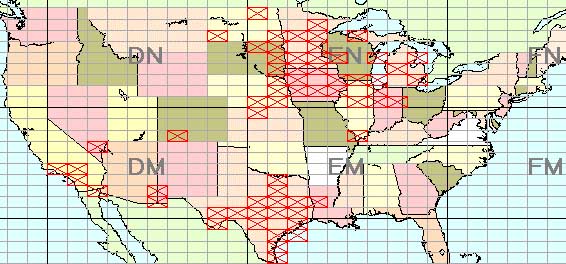
6 Meter Grid Map....
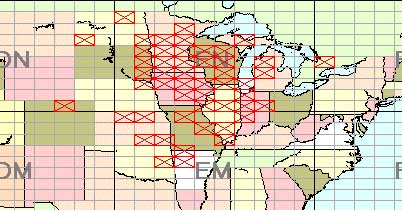
2 Meter Grid Map....
See ya next June!
73
Mike - KMØT EN13vc